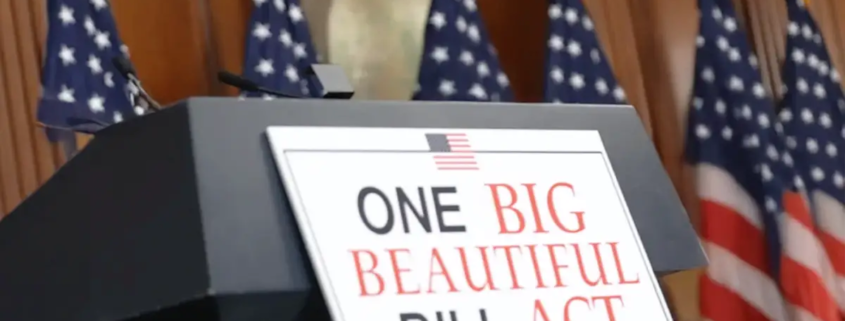One Big Beautiful Bill Act – Details we know about changes to Taxes, etc…
What We Know About the New BBB Tax Bill So Far
Everyone wants to know more about the “One Big Beautiful Bill Act” (OBBBA) signed into law by President Donald J. Trump on July 4, 2025. As with any new tax legislation, the IRS is sure to weigh in on with clarifications later about certain provisions, especially as this bill is almost 900 pages long. But in the meantime, here are 10 things we know now:
1. Lower Income Tax Rates Were Made Permanent
The tax rates which have been in effect since 2017 by the passage of the Tax Cuts and Jobs Act (TCJA) are made permanent in the OBBBA. There are seven rates which vary by filing status per the IRS.
- For tax year 2025, the top tax rate remains 37% for individual single taxpayers with incomes greater than $626,350 ($751,600 for married couples filing jointly).
- 35% for incomes over $250,525 ($501,050 for married couples filing jointly).
- 32% for incomes over $197,300 ($394,600 for married couples filing jointly).
- 24% for incomes over $103,350 ($206,700 for married couples filing jointly).
- 22% for incomes over $48,475 ($96,950 for married couples filing jointly).
- 12% for incomes over $11,925 ($23,850 for married couples filing jointly).
- 10% for incomes $11,925 or less ($23,850 or less for married couples filing jointly).
2. Higher Standard Deductions Were Made Permanent
The TCJA of 2017 increased the standard deduction for people who don’t itemize; and the OBBBA made higher standard deductions permanent. Starting in 2025 the standard deduction amount will be $31,500 for joint filers and $15,750 for single filers. The standard deduction amount will be adjusted for inflation in subsequent tax years.
3. Higher Lifetime Gift or Estate Exemption Amounts Were Made Permanent
The higher estate or lifetime gifting exemption amounts put in place by the 2017 TCJA are made permanent in the new bill. For the 2025 tax year, the exemption is $13.99 million per individual. Per the OBBBA, in 2026, the estate and lifetime gifting exemption amount will be $15,000,000.00 per person, ($30,000,000.00 for a married couple), with the new exemption amount indexed for inflation going forward.
4. The SALT (State and Local Income Tax) Itemized Deduction Cap Is Increased Temporarily
Before 2018, there was no limit on the amount that could be deducted for state and local income taxes. Then the 2017 TCJA imposed a cap of $10,000 for married couples filing jointly from 2018 through 2025. Per the OBBBA, the cap on the itemized deduction for state and local taxes is increased to $40,000 for the 2025 tax year, and increases by 1% through 2029, subject to a phaseout for taxpayers with incomes above $500,000. In 2030, the cap reduces back down to $10,000.
5 A Temporary Income Tax Deduction Was Created for Seniors
Mistakenly referred to as a Social Security tax cut, the OBBBA established a temporary income tax deduction for people age 65 or older. For tax years 2025 through 2028, $6,000 can be deducted per eligible filer—provided their modified adjusted gross income does not exceed $75,000 for single filers, or $150,000 for those married filing jointly.
6. A Temporary Income Tax Deduction Was Created for Those Who Claim Tips
7. A Temporary Income Tax Deduction Was Created for Overtime
Per the OBBBA, for the tax years 2025 through 2028, up to $25,000 of overtime compensation for married filers and $12,500 for single filers may be deducted from federal taxable income. The deduction phases out when adjusted gross income exceeds $150,000 for single filers and $300,000 for joint filers.<.li>
8. A Temporary Income Tax Deduction Was Created for Car Loan Interest
For the tax years 2025 through 2028, auto loan interest is made income tax deductible for new autos with final assembly in the United States. The deduction is limited to $10,000 and phases out when income exceeds $100,000 for single filers and $200,000 for joint filers.NOTE: The clean vehicle credit created by the Inflation Reduction Act of 2022 slated to be in effect through 2032 was abolished by the OBBBA for clean energy vehicles purchased after September 30, 2025.
9. The Child Tax Credit Was Increased Slightly, Deduction Amount Reduced, and Both Made Permanent
The child tax credit raised previously allowed eligible taxpayers to reduce their federal income tax liability by up to $2,000 per qualifying child, with a refund up to $1,700 per child if federal tax liability was not high enough to claim the credit. The OBBBA raised this amount to $2,200 per child for 2025, while lowering the refundable amount to $1,400 from its current$1,700; and earned income must be at least $2,500 to claim. Beginning in 2026, both are made permanent and will be indexed for infl ation.
10. New Trump Accounts for Kids for 2025 Through 2028
For American children born between Jan. 1, 2025, and Dec. 31, 2028 who have a Social Security number, the OBBB establishes a special trust designed to give children a head start financially. Formerly called “Money Accounts for Growth and Advancement,” or “MAGA accounts,” the Trump Accounts must be invested in an “eligible investment” in the stock market, such as a mutual fund or exchange-traded fund (ETF) that tracks an index like the S&P 500. A one-time $1,000 credit will be granted by the Department of the Treasury. The fund cannot have annual fees and expenses of more than 0.1% and must be comprised of “equity investments in primarily United States companies.”More details are forthcoming, but parents can establish the accounts, or the government will establish accounts for them. Although not required, parents, relatives, and others are also able to contribute up to $5,000 a year. Employers can chip in, though special rules apply to them; and a company can deposit up to $2,500 into an account for an employee’s eligible dependent child without adding to the worker’s taxable income.
Trump Accounts resemble traditional IRAs, except contributions made before the beneficiary’s 18th birth year aren’t deductible and have a lower annual cap. Unlike an IRA, there’s no earned income requirement to start. Contributions made after a child’s 18th year generally follow traditional IRA rules. The IRA contribution limit in 2025 is $7,000 for those under age 50. The money invested grows tax-deferred, and withdrawals are taxed as ordinary income.
https://www.irs.gov/newsroom/irs-releases-tax-inflation-adjustments-for-tax-year- 2025
https://www.congress.gov/crs-product/R41873
https://ktla.com/news/consumer-business/1k-trump-accounts-for-kids-how-do-they- stack-up/
https://www.npr.org/2025/07/08/nx-s1-5455647/trump-accounts-babies-what-to- know
https://www.cnbc.com/2025/07/11/when-provisions-from-trumps-big-beautiful-bill- go-into-effect.html





